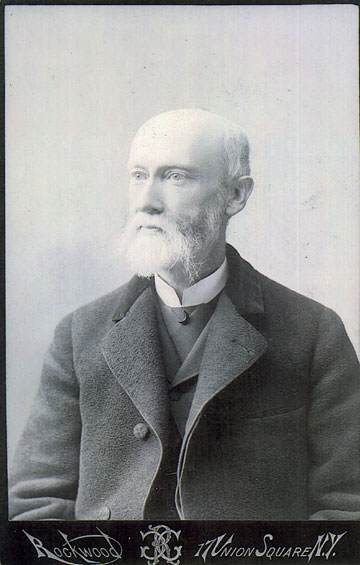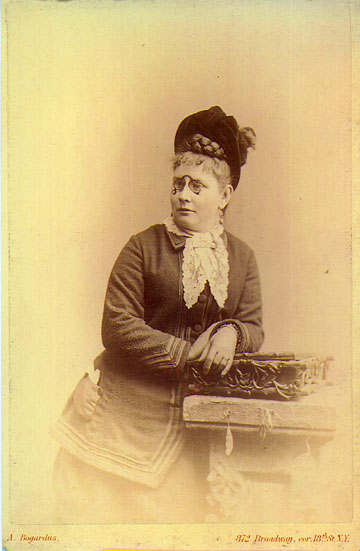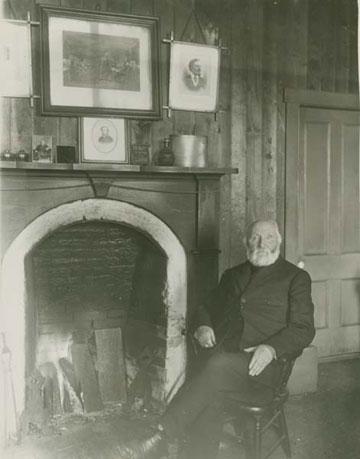 "Cruising to Alaska, Circa 1887" A Journal of a Trip on the Ancon and An Eyewitness to the Founding of Metlakatla By DAVE KIFFER August 07, 2007
For example, if you wanted to take a sightseeing trip up the Inside Passage to Alaska, your choices in ships were somewhat limited. Only a couple of companies had regular runs into Southeast Alaska - mostly in the summer months - and those runs were often interrupted or cut short by bad weather and frequent groundings.
Rudimentary steamships made the trip from Seattle and Portland and other points along the coast. Most of the ships were 20 to 30 years old, considered ancient at a time when ship technology was rapidly changing from sail to steam to gasoline and diesel engines. One such ship was the Ancon, a side-wheel paddle steamer that came on the "Alaska run" in 1886. A year later, Frederick Jarvis Slade, 43 and his wife Amy Lane Slade, 40, boarded the Ancon for a trip to Alaska. Frederick Slade kept a journal of his trip, which noted the scenery, the native customs and such interesting tidbits as the arrival - on the Ancon - of Father William Duncan to his new community of Metlakatla on Annette Island (see "The Founding of Metlakatla" SITNEWS, Aug. 7, 2006). Frederick Slade's 100 page journal now belongs to his great-great grandson, Mel Stephens, an attorney who has lived in Kodiak since 1980. Ancon's Alaska History Short The Ancon had been on the "Alaska" run for just about a year, when the Slades rode on her. She had already had one serious accident, in Glacier Bay on September 13, 1886. The New York Times was sponsoring an "Alaska Expedition" in 1886 to drum up interest in the Inside Passage to Alaska. "The vessel ran upon an unknown rock, breaking a hole in her bottom 3 or 4 feet wide by 20 feet in length.," Pioneering Alaska explorer Frederick Schwatka wrote several weeks later in the October of 1886. "The fires in the furnace were extinguished within half an hour. The rising tide floated the ship, however, within an hour, and setting sail the Ancon was beached nearly two miles from the rock, just in time to save her from being a total loss. Two weeks later the Ancon's passengers were taken on board the steamship Idaho, on which vessel THE TIMES expedition returned." That wreck would presage the wreck that would destroy the Ancon in Loring three years later. (see "A Famous Artist Runs Aground in Loring," SITNEWS February 13, 2007) When the Ancon was launched on October 12, 1865 by the Pacific Mail Steamship Company it was considered a "state of the art" side paddle steamer. "The company built the ship to serve as a ferryboat to run in the vicinity of Panama," according to Pelham, New York town historian Blake A. Bell, who wrote a story about the Ancon's sinking in Loring and its connection to Pelham through a young man - Benjamin Fairchild who was on board the Ancon and later became a New York congressman and a prominent developer. "Only four years later , however, the ship was refitted for sea service including the addition of a bow." Bell wrote that the Ancon became a "coasting steamer" in 1870, ferrying mail packets, cargo and early tourists up the Pacific Coast and providing some of the earliest service to the Pacific Northwest. "As time past, however, improvements in steamship technology left the Ancon behind," Bell wrote in 2006. "By the late 1880s, Steamboat men considered the Ancon 'an old boat.' After the Ancon sank in Loring in 1889, the New York Times reported that the ship had "long been regarded as more or less unsafe." Slade Interested in Mining But those concerns were obviously not passed along to the passengers like Mr. and Mrs. Slade in 1887. Frederick Slade a prominent resident of Trenton, New Jersey when he voyaged to Alaska. He and his wife had previously traveled to Florida, Colorado and Mexico City at various times. Slade, a Civil War veteran, was a machinist and engineer by trade and a member of the American Society of Mining Engineers. He spent time in Europe studying machining and steel production and, over time, worked his way up to treasurer of the New Jersey Iron and Steel Company, according to his obituary in the Trenton newspaper, only four years after his Alaskan trip. 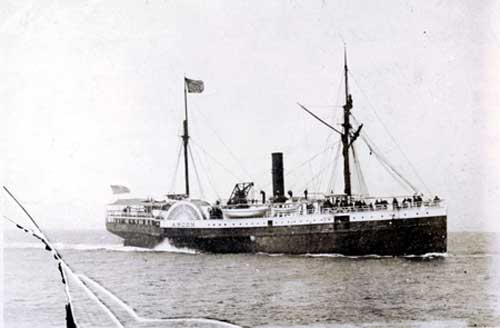 Donor: Bertha Hunt Wells, Tongass Historical Society Photograph courtesy Ketchikan Museums
The Santa Fe railroad had just reached Los Angeles the year before, starting a "bidding war" with the Southern Pacific and creating fares as low as $20 from the East Coast, according the official Los Angeles city history. The population had briefly peaked at nearly 50,000 when the Slades visited, but a speculation boom and bust would cause a short depression and send the population down. It would be 1890 before it would recover its relentless upward climb to the point where the modern city is the second largest in the country. The Los Angeles that the Slades saw was much different from the modern downtown Los Angeles. "The (Pico) house (hotel where they stayed) stands on a circular plaza with the old mission church on the left whose jangling bells were the first thing we heard on awakening. The sun was very bright but not hot, " Slade wrote on June 26. "Attended church at 1st Presbyterian - good sermon. In afternoon I walked up on hills on which the residences are situated and got a good view of the plain below with its orange groves and of the mountains. In the evening attended service at the congregational church. Flowers grow here in profusion and tropical plants including bananas are in the front yards of the houses." Mr. and Mrs. Slade continued their trip by taking the train up the coast, including stops at Yosemite, San Francisco and Lake Tahoe. They had now traveled more than 4,000 miles. They crossed Nevada by stage coach and arrived in Salt Lake City on July 8. The couple stayed a few days - visiting at least one silver mine, as well as the Mormon Tabernacle. Slade noted - somewhat dryly in his journal - that the Mormon church seemed to be thriving despite reports Back East and elsewhere to the contrary. They then headed further north through Idaho and into Montana where Jarvis took particular interest in the mining properties around Butte and Anaconda. They also visited Yellowstone National Park, which was then only 25 years old. Mr. Slade's interest in geology expanded his journal entries into several pages as he described the natural wonders of the Yellowstone Basin. Continuing their journey, they headed to the Columbia River and reached Portland by July 25. There they repacked for their Alaska journey after making side trips to Astoria and Eugene. They arrived in Seattle on July 30th. Slade noted that they had traveled 8,005 miles since leaving Trenton six weeks earlier. Seattle Growing But Not Big Seattle in the summer of 1887 was growing but was still a decade away from the big boom of the Klondike gold rush. "Took a walk before church," Slade noted on July 31st. "The City is built on the side of a steep hill so the houses in each street overlook those in the street below. Green grass and flowers surround each house and the outlook over the sound is charming. The air is cool (75° at 3.30 PM). There was a fair congregation at the Presbyterian church perhaps 75. In the afternoon we attended a good Y.M.C.A. meeting about the same number present and four rose for prayer. Good singing. In the morning the sky was overhung with fog but in the afternoon the sun shown beautifully. This seems the usual course of the weather." 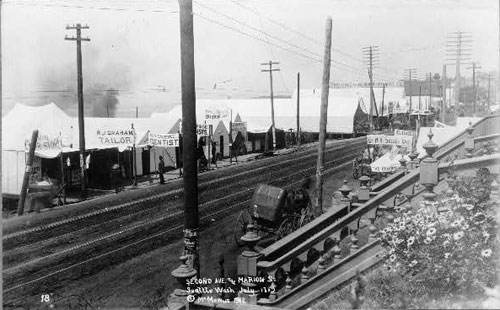 U.S. GEOG FILE - Washington--Seattle -- Copyright by McManus Photo courtesy Library of Congress Prints and Photographs Division Washington, D.C.
"Breakfasted at 6 AM expecting to take the boat at 7 but she was late and we did not get off till after 9.30," Slade wrote on August 1, 1887 "At Port Townsend found that the Ancon had not yet arrived having gone first to Nanaimo for coal, so we continued on the boat to Victoria reaching there about 5.30. The sail across the straights of San Juan de Fuca was not as enjoyable as on the sound as even at this distance of 100 miles from the ocean there was quite a swell - all in fact that we could stand with comfort." Later in the day, the couple arrived in Victoria, British Columbia and awaited the Ancon's arrival. They boarded it the next morning. And took the brief side trip back to Port Townsend where the ship officially began its journey north. In those days, the Ancon charged approximately $40 for the trip to Alaska and back, although Slade does not record the amount he paid in his journal. The Ancon generally stopped at the major towns in southeast Alaska - Wrangell, Juneau and Sitka - and also made stops at canneries such as Loring to pick up supplies and cargo. 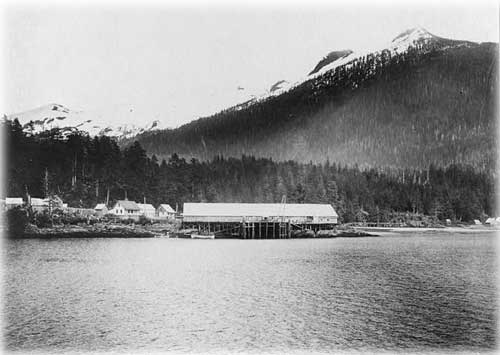 Forms part of: Frank and Frances Carpenter collection (Library of Congress). Gift; Mrs. W. Chapin Huntington; 1951. Library of Congress Prints and Photographs Division Washington, D.C. Photograph courtesy Library of Congress
Over the next several days - from August 1 through August 6th, Slade recorded the sights on the British Columbia coast, including the infamous Ripple Rock and the village of old Metlakatla. On August 7th, he recorded a possible visit to the as yet unnamed community of Ketchikan, but it is not entirely certain it was the same cannery because mariners occasionally called the entire area from Tree Point north as "Tongass Narrows." and there were other canneries between the border and modern Ketchikan. "A bright clear morning," Slade wrote. "The ship lying at a cannery in Tongass Narrows, the water swarming with fish which were constantly jumping out of the water to the height of two or three feet. I landed in a little boat and went a little ways up the mountain stream which falls in here. It lay in a beautiful moss covered glen with a profusion of ferns and every variety of greenness covering rocks and trees. The fish lay in swarms in the pools at the foot of the various cascades and could be taken in the hand if one could hold them. Where the water was still they could be seen lying side by side almost as closely as they could be packed, and they could be seen shooting up the falls, sometimes being swept back but never giving up the attempt. The Indians hook them out of these pools with great facility using a sharp hook on the end of a pole but those of our party who tried it did not prove so expert." The Founding of Metlakatla At noon, the Ancon motored over to Port Chester to take Father Duncan and other visiting dignitaries to the new community of Metlakatla.
"Here we all went ashore to take part in a simple service in connection with raising the flag over the new settlement," Slade wrote. "About 30 of the Indians had already come here and had erected a few log houses and a log building for a store. It was very interesting to see the cordiality and respect with which they welcomed Mr. Duncan the men politely raising their hats as they shook hands with him and each man & woman seeming delighted to welcome him among them again. They put out their hands to shake ours also. After a few moments Mr. Duncan addressed them telling them what he had been doing in Washington and introduced Mr. Dawson of the Educational Bureau of the Govt. who assured them of the protection and aid of the Govt. in their endeavors toward better civilization. "Mr. Duncan interpreted his remarks to them and I was much struck with the grave attention with which they listened to everything he said.," Slade continued. "Dr. Fraser of Oakland then offered prayer during which all kneeled reverently, and the Indians then sang a hymn to the tune of Grenville, singing all the parts as they have been taught to do by Mr. D. as in their native state they sing only in unison. The flag was then unfurled and then immediately saluted by a shot from our steamer which re-echoed from mountain to mountain. "We (the whites) then sang Coronation, after which the assembly was dismissed with the benediction.," Slade went on. "Before the benediction one of the Indians made an address to us in his native language in response to those that had been made by us. Mr. Duncan noted it down and translated it to us. It was a remarkable address from its earnestness and evident sincerity. The whole spectacle was most beautiful and impressive. The beautiful bay surrounded by a semi-circle of mountains lying peacefully before us, the steamer - messenger from far off regions - lying upon its bosom, the group of swarthy men women & children gathered beneath the flag staff on the sloping shore listening to and uttering words of encouragement and devotion. 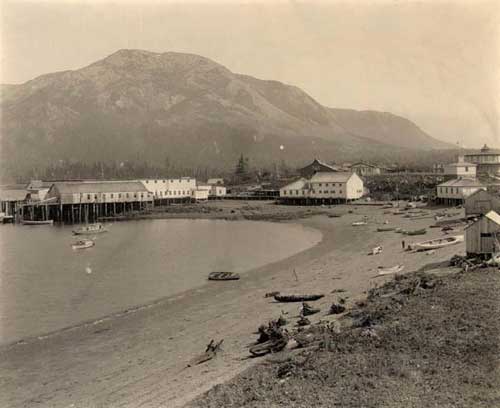 Photographer: Harriet Hunt Donor: Forest J. Hunt, Tongass Historical Society 62.4.5.175 Photograph courtesy Ketchikan Museums
Loring Was 'Charming' Next, the Ancon traveled up the coast to Loring. "This is a most charming spot," Slade wrote on August 8th. "The steamer winds its way among numerous islands to a narrow secluded bay lying between steep banks covered with trees, ferns, moss, berries verdure of every imaginable shade of green and the greatest luxuriance. Beneath the overhanging branches of the trees the deep shadows in the water or in some little recess or inlet contrasted most beautifully with the bright green foliage in the grass upon the banks." 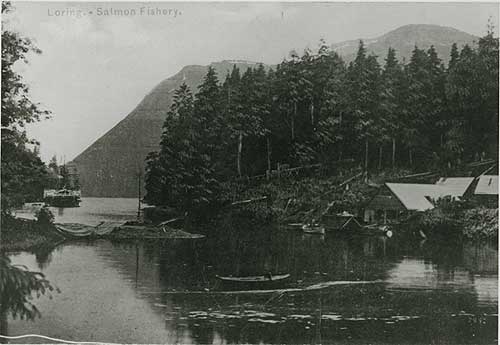 Donor: Sixten Johanson, Tongass Historical Society Photograph courtesy Ketchikan Museums
"This is a very dilapidated town situated on a low hillside dripping with moisture and buried in tall grass and rank weeds.," he wrote on August 9th He was particularly not impressed by the missionary school in the village. "It certainly did not look very inviting as it seemed dirty and dingy." Slade had a better impression of Juneau which he called an "American town." The mining engineer in him was favorably impressed by the "great Treadwell gold mine" on Douglas Island across from Juneau. The Ancon continued on to Chilcat (Haines/Klukwan) and then went to Glacier Bay, which Slade touted as more spectacular than anything in Switzerland and the Alps.  Photograph shows street scene and buildings, including the "New England Shoe Shop" in Juneau, Alaska. Copyright by F.D. Fujiwara. Photo courtesy Library of Congress Prints and Photographs Division Washington, D.C.
In Sitka, Mr. and Mrs. Slade decided to switch to the steamer Olympian for the trip south, because the Ancon was already several days behind schedule and the Olympian was a faster boat. On April 15, they headed south on the Olympian and didn't note any other stops on their way back to Vancouver, although Slade wrote that the trip had "the usual variety of beautiful scenery all day." They reached Victoria on the 18th and Vancouver on the 19th and then took Canadian railroads back across the continent. On August 23, 1887, the Slades reached Trenton. Frederick Slade estimated their total miles traveled at 13,870. Frederick Slade died four years later in Trenton. His obituary called him one of Trenton's "best citizens and most useful businessmen" and noted that "his departure will create a great void in the community." Amy Slade lived until 1915. Mel Stephens says he plans
to publish his great-great grandfather's complete 1887 travel
journal at some point in the near future. On the Web:
Dave Kiffer is a freelance writer living in Ketchikan, Alaska. To republish this article, the author requires a publication fee. Contact Dave at dave@sitnews.us
|
|||
